Financial Decision Making: Ratio Analysis of Panini Ltd BM414 Report
VerifiedAdded on 2023/06/10
|14
|3961
|139
Report
AI Summary
This report provides a financial analysis of Panini Ltd, a medium-sized bread-making company, focusing on the roles of accounting and finance functions within the business. It examines various financial ratios, including Net Profit Ratio, ROCE, Current Ratio, and Liquidity Ratio, calculated for two years to assess the company's financial position. The report also discusses the sources of finance available for a medium-sized company like Panini Ltd for expansion purposes, such as retained earnings, equity capital, and debt capital. Task 1 details accounting and finance departments and its functions while Task 2 provides ratio calculation and analysis, offering reasons and recommendations based on the results to ascertain the company's financial standing and inform decision-making.

PANINI LIMITED
Paraphrase This Document
Need a fresh take? Get an instant paraphrase of this document with our AI Paraphraser
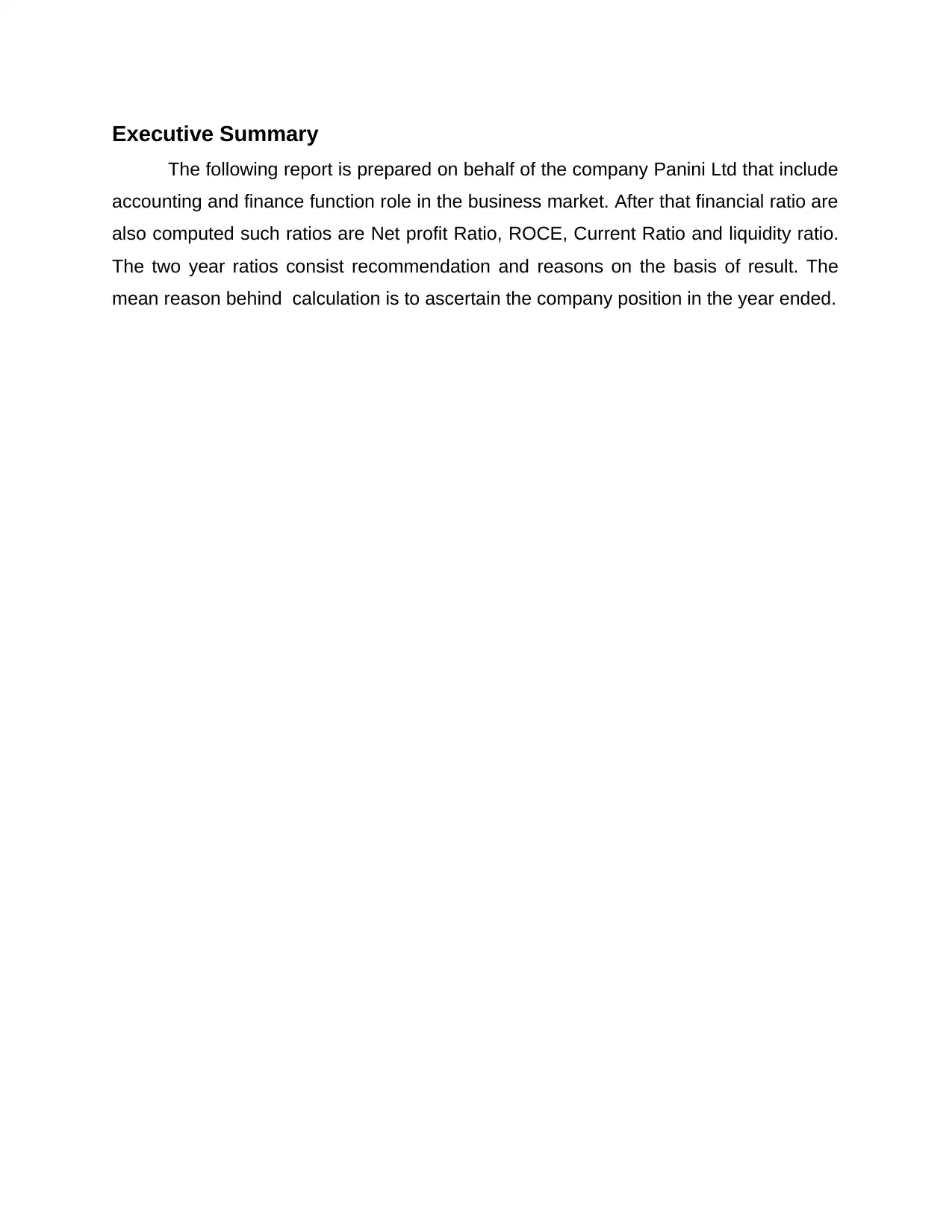
Executive Summary
The following report is prepared on behalf of the company Panini Ltd that include
accounting and finance function role in the business market. After that financial ratio are
also computed such ratios are Net profit Ratio, ROCE, Current Ratio and liquidity ratio.
The two year ratios consist recommendation and reasons on the basis of result. The
mean reason behind calculation is to ascertain the company position in the year ended.
The following report is prepared on behalf of the company Panini Ltd that include
accounting and finance function role in the business market. After that financial ratio are
also computed such ratios are Net profit Ratio, ROCE, Current Ratio and liquidity ratio.
The two year ratios consist recommendation and reasons on the basis of result. The
mean reason behind calculation is to ascertain the company position in the year ended.
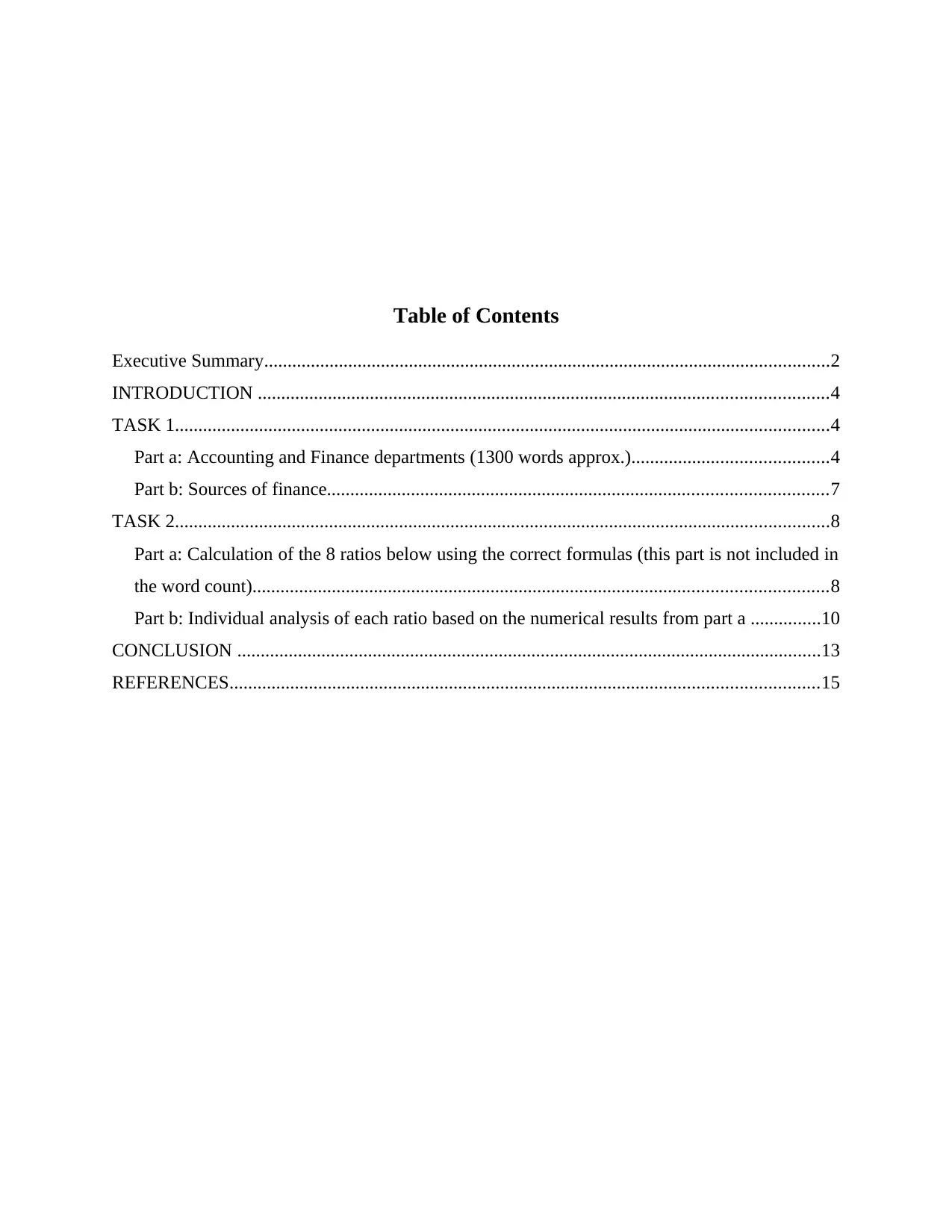
Table of Contents
Executive Summary.........................................................................................................................2
INTRODUCTION ..........................................................................................................................4
TASK 1............................................................................................................................................4
Part a: Accounting and Finance departments (1300 words approx.)..........................................4
Part b: Sources of finance...........................................................................................................7
TASK 2............................................................................................................................................8
Part a: Calculation of the 8 ratios below using the correct formulas (this part is not included in
the word count)...........................................................................................................................8
Part b: Individual analysis of each ratio based on the numerical results from part a ...............10
CONCLUSION .............................................................................................................................13
REFERENCES..............................................................................................................................15
Executive Summary.........................................................................................................................2
INTRODUCTION ..........................................................................................................................4
TASK 1............................................................................................................................................4
Part a: Accounting and Finance departments (1300 words approx.)..........................................4
Part b: Sources of finance...........................................................................................................7
TASK 2............................................................................................................................................8
Part a: Calculation of the 8 ratios below using the correct formulas (this part is not included in
the word count)...........................................................................................................................8
Part b: Individual analysis of each ratio based on the numerical results from part a ...............10
CONCLUSION .............................................................................................................................13
REFERENCES..............................................................................................................................15
⊘ This is a preview!⊘
Do you want full access?
Subscribe today to unlock all pages.

Trusted by 1+ million students worldwide
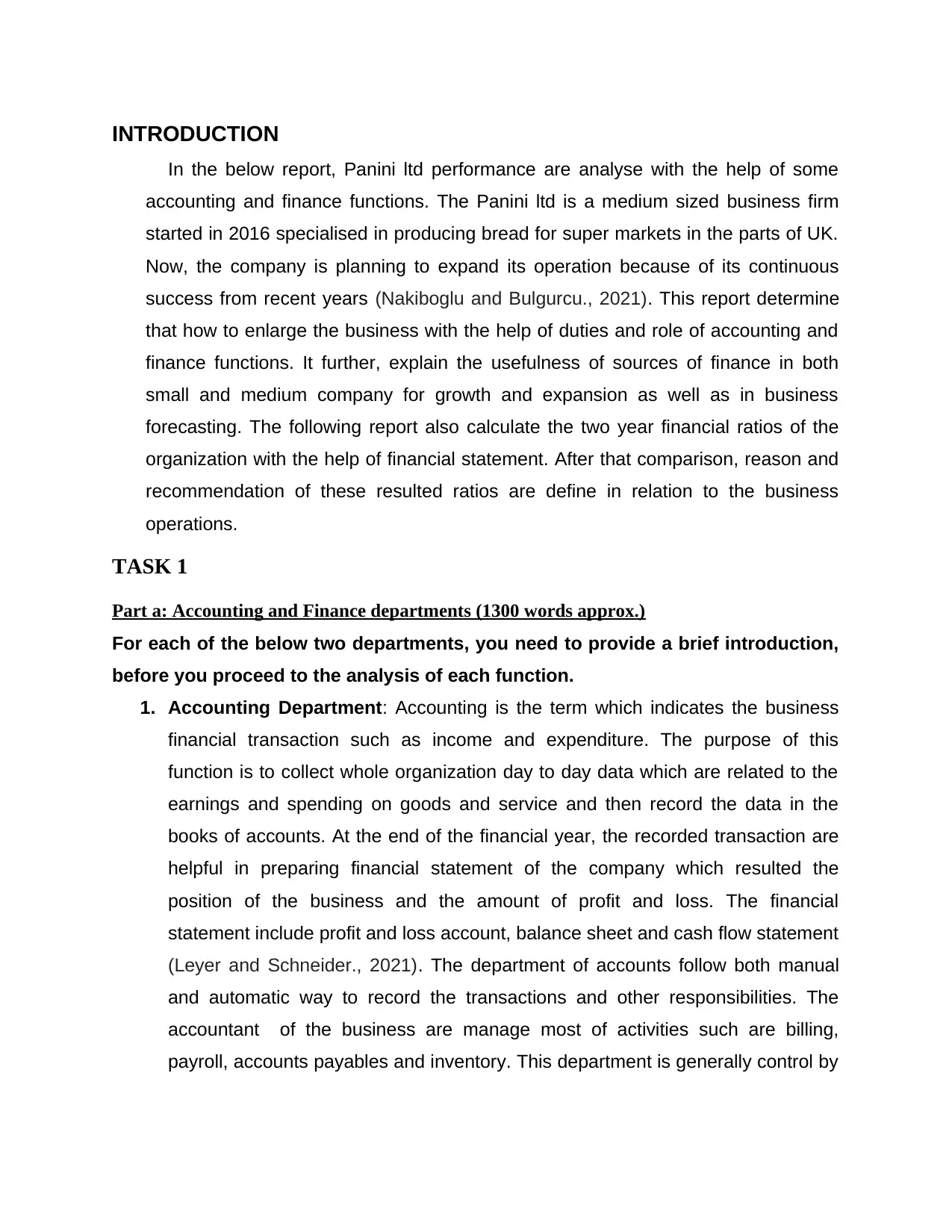
INTRODUCTION
In the below report, Panini ltd performance are analyse with the help of some
accounting and finance functions. The Panini ltd is a medium sized business firm
started in 2016 specialised in producing bread for super markets in the parts of UK.
Now, the company is planning to expand its operation because of its continuous
success from recent years (Nakiboglu and Bulgurcu., 2021). This report determine
that how to enlarge the business with the help of duties and role of accounting and
finance functions. It further, explain the usefulness of sources of finance in both
small and medium company for growth and expansion as well as in business
forecasting. The following report also calculate the two year financial ratios of the
organization with the help of financial statement. After that comparison, reason and
recommendation of these resulted ratios are define in relation to the business
operations.
TASK 1
Part a: Accounting and Finance departments (1300 words approx.)
For each of the below two departments, you need to provide a brief introduction,
before you proceed to the analysis of each function.
1. Accounting Department: Accounting is the term which indicates the business
financial transaction such as income and expenditure. The purpose of this
function is to collect whole organization day to day data which are related to the
earnings and spending on goods and service and then record the data in the
books of accounts. At the end of the financial year, the recorded transaction are
helpful in preparing financial statement of the company which resulted the
position of the business and the amount of profit and loss. The financial
statement include profit and loss account, balance sheet and cash flow statement
(Leyer and Schneider., 2021). The department of accounts follow both manual
and automatic way to record the transactions and other responsibilities. The
accountant of the business are manage most of activities such are billing,
payroll, accounts payables and inventory. This department is generally control by
In the below report, Panini ltd performance are analyse with the help of some
accounting and finance functions. The Panini ltd is a medium sized business firm
started in 2016 specialised in producing bread for super markets in the parts of UK.
Now, the company is planning to expand its operation because of its continuous
success from recent years (Nakiboglu and Bulgurcu., 2021). This report determine
that how to enlarge the business with the help of duties and role of accounting and
finance functions. It further, explain the usefulness of sources of finance in both
small and medium company for growth and expansion as well as in business
forecasting. The following report also calculate the two year financial ratios of the
organization with the help of financial statement. After that comparison, reason and
recommendation of these resulted ratios are define in relation to the business
operations.
TASK 1
Part a: Accounting and Finance departments (1300 words approx.)
For each of the below two departments, you need to provide a brief introduction,
before you proceed to the analysis of each function.
1. Accounting Department: Accounting is the term which indicates the business
financial transaction such as income and expenditure. The purpose of this
function is to collect whole organization day to day data which are related to the
earnings and spending on goods and service and then record the data in the
books of accounts. At the end of the financial year, the recorded transaction are
helpful in preparing financial statement of the company which resulted the
position of the business and the amount of profit and loss. The financial
statement include profit and loss account, balance sheet and cash flow statement
(Leyer and Schneider., 2021). The department of accounts follow both manual
and automatic way to record the transactions and other responsibilities. The
accountant of the business are manage most of activities such are billing,
payroll, accounts payables and inventory. This department is generally control by
Paraphrase This Document
Need a fresh take? Get an instant paraphrase of this document with our AI Paraphraser
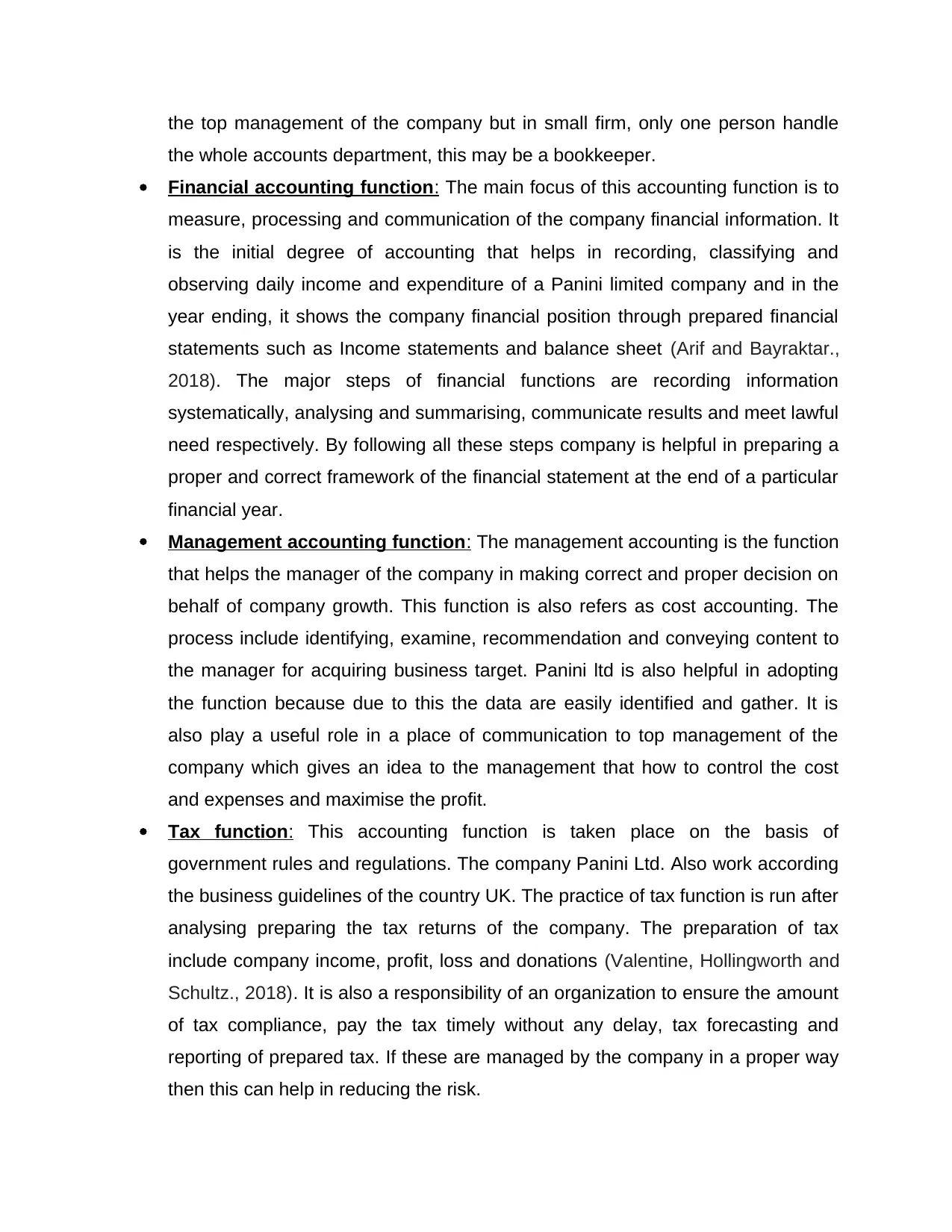
the top management of the company but in small firm, only one person handle
the whole accounts department, this may be a bookkeeper.
Financial accounting function: The main focus of this accounting function is to
measure, processing and communication of the company financial information. It
is the initial degree of accounting that helps in recording, classifying and
observing daily income and expenditure of a Panini limited company and in the
year ending, it shows the company financial position through prepared financial
statements such as Income statements and balance sheet (Arif and Bayraktar.,
2018). The major steps of financial functions are recording information
systematically, analysing and summarising, communicate results and meet lawful
need respectively. By following all these steps company is helpful in preparing a
proper and correct framework of the financial statement at the end of a particular
financial year.
Management accounting function: The management accounting is the function
that helps the manager of the company in making correct and proper decision on
behalf of company growth. This function is also refers as cost accounting. The
process include identifying, examine, recommendation and conveying content to
the manager for acquiring business target. Panini ltd is also helpful in adopting
the function because due to this the data are easily identified and gather. It is
also play a useful role in a place of communication to top management of the
company which gives an idea to the management that how to control the cost
and expenses and maximise the profit.
Tax function: This accounting function is taken place on the basis of
government rules and regulations. The company Panini Ltd. Also work according
the business guidelines of the country UK. The practice of tax function is run after
analysing preparing the tax returns of the company. The preparation of tax
include company income, profit, loss and donations (Valentine, Hollingworth and
Schultz., 2018). It is also a responsibility of an organization to ensure the amount
of tax compliance, pay the tax timely without any delay, tax forecasting and
reporting of prepared tax. If these are managed by the company in a proper way
then this can help in reducing the risk.
the whole accounts department, this may be a bookkeeper.
Financial accounting function: The main focus of this accounting function is to
measure, processing and communication of the company financial information. It
is the initial degree of accounting that helps in recording, classifying and
observing daily income and expenditure of a Panini limited company and in the
year ending, it shows the company financial position through prepared financial
statements such as Income statements and balance sheet (Arif and Bayraktar.,
2018). The major steps of financial functions are recording information
systematically, analysing and summarising, communicate results and meet lawful
need respectively. By following all these steps company is helpful in preparing a
proper and correct framework of the financial statement at the end of a particular
financial year.
Management accounting function: The management accounting is the function
that helps the manager of the company in making correct and proper decision on
behalf of company growth. This function is also refers as cost accounting. The
process include identifying, examine, recommendation and conveying content to
the manager for acquiring business target. Panini ltd is also helpful in adopting
the function because due to this the data are easily identified and gather. It is
also play a useful role in a place of communication to top management of the
company which gives an idea to the management that how to control the cost
and expenses and maximise the profit.
Tax function: This accounting function is taken place on the basis of
government rules and regulations. The company Panini Ltd. Also work according
the business guidelines of the country UK. The practice of tax function is run after
analysing preparing the tax returns of the company. The preparation of tax
include company income, profit, loss and donations (Valentine, Hollingworth and
Schultz., 2018). It is also a responsibility of an organization to ensure the amount
of tax compliance, pay the tax timely without any delay, tax forecasting and
reporting of prepared tax. If these are managed by the company in a proper way
then this can help in reducing the risk.
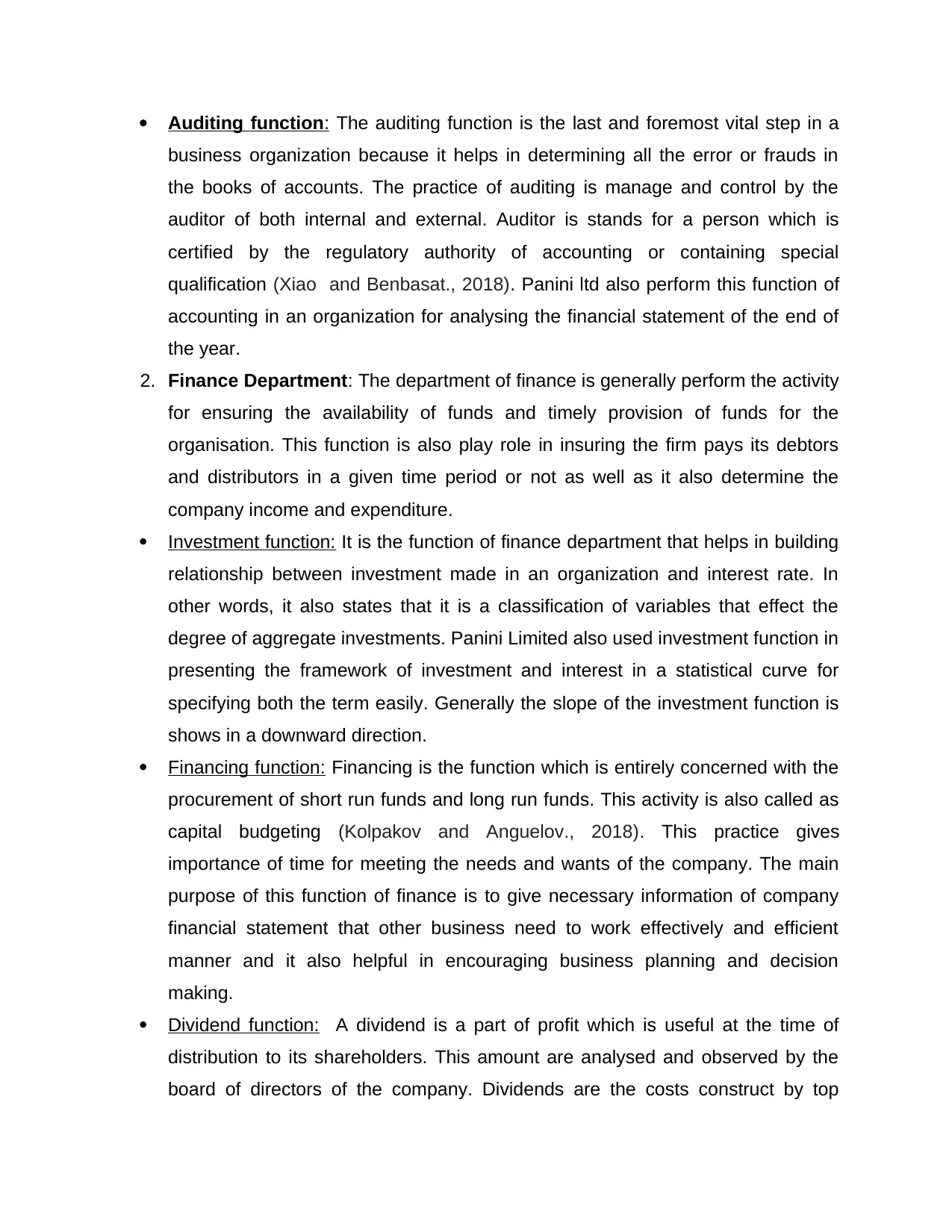
Auditing function: The auditing function is the last and foremost vital step in a
business organization because it helps in determining all the error or frauds in
the books of accounts. The practice of auditing is manage and control by the
auditor of both internal and external. Auditor is stands for a person which is
certified by the regulatory authority of accounting or containing special
qualification (Xiao and Benbasat., 2018). Panini ltd also perform this function of
accounting in an organization for analysing the financial statement of the end of
the year.
2. Finance Department: The department of finance is generally perform the activity
for ensuring the availability of funds and timely provision of funds for the
organisation. This function is also play role in insuring the firm pays its debtors
and distributors in a given time period or not as well as it also determine the
company income and expenditure.
Investment function: It is the function of finance department that helps in building
relationship between investment made in an organization and interest rate. In
other words, it also states that it is a classification of variables that effect the
degree of aggregate investments. Panini Limited also used investment function in
presenting the framework of investment and interest in a statistical curve for
specifying both the term easily. Generally the slope of the investment function is
shows in a downward direction.
Financing function: Financing is the function which is entirely concerned with the
procurement of short run funds and long run funds. This activity is also called as
capital budgeting (Kolpakov and Anguelov., 2018). This practice gives
importance of time for meeting the needs and wants of the company. The main
purpose of this function of finance is to give necessary information of company
financial statement that other business need to work effectively and efficient
manner and it also helpful in encouraging business planning and decision
making.
Dividend function: A dividend is a part of profit which is useful at the time of
distribution to its shareholders. This amount are analysed and observed by the
board of directors of the company. Dividends are the costs construct by top
business organization because it helps in determining all the error or frauds in
the books of accounts. The practice of auditing is manage and control by the
auditor of both internal and external. Auditor is stands for a person which is
certified by the regulatory authority of accounting or containing special
qualification (Xiao and Benbasat., 2018). Panini ltd also perform this function of
accounting in an organization for analysing the financial statement of the end of
the year.
2. Finance Department: The department of finance is generally perform the activity
for ensuring the availability of funds and timely provision of funds for the
organisation. This function is also play role in insuring the firm pays its debtors
and distributors in a given time period or not as well as it also determine the
company income and expenditure.
Investment function: It is the function of finance department that helps in building
relationship between investment made in an organization and interest rate. In
other words, it also states that it is a classification of variables that effect the
degree of aggregate investments. Panini Limited also used investment function in
presenting the framework of investment and interest in a statistical curve for
specifying both the term easily. Generally the slope of the investment function is
shows in a downward direction.
Financing function: Financing is the function which is entirely concerned with the
procurement of short run funds and long run funds. This activity is also called as
capital budgeting (Kolpakov and Anguelov., 2018). This practice gives
importance of time for meeting the needs and wants of the company. The main
purpose of this function of finance is to give necessary information of company
financial statement that other business need to work effectively and efficient
manner and it also helpful in encouraging business planning and decision
making.
Dividend function: A dividend is a part of profit which is useful at the time of
distribution to its shareholders. This amount are analysed and observed by the
board of directors of the company. Dividends are the costs construct by top
⊘ This is a preview!⊘
Do you want full access?
Subscribe today to unlock all pages.

Trusted by 1+ million students worldwide
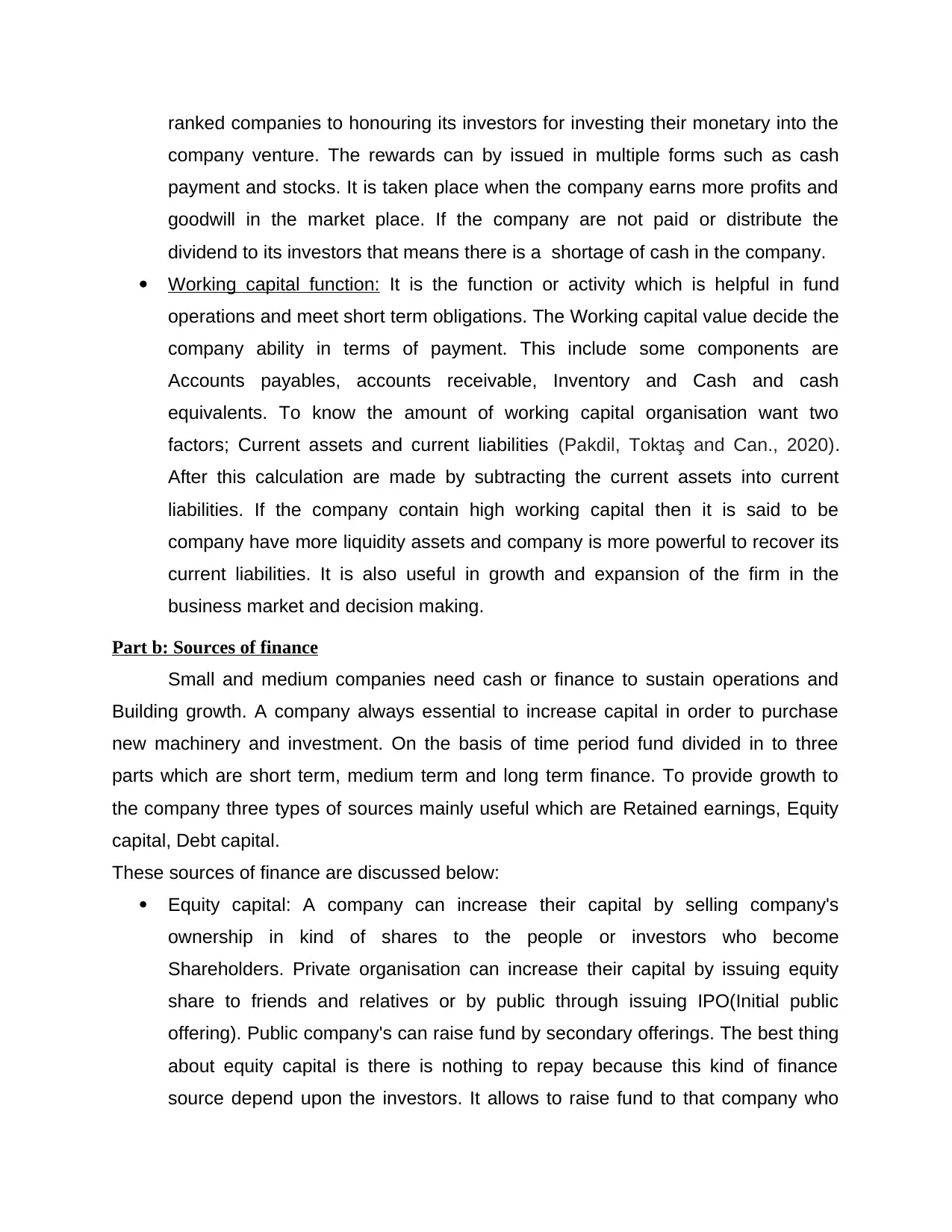
ranked companies to honouring its investors for investing their monetary into the
company venture. The rewards can by issued in multiple forms such as cash
payment and stocks. It is taken place when the company earns more profits and
goodwill in the market place. If the company are not paid or distribute the
dividend to its investors that means there is a shortage of cash in the company.
Working capital function: It is the function or activity which is helpful in fund
operations and meet short term obligations. The Working capital value decide the
company ability in terms of payment. This include some components are
Accounts payables, accounts receivable, Inventory and Cash and cash
equivalents. To know the amount of working capital organisation want two
factors; Current assets and current liabilities (Pakdil, Toktaş and Can., 2020).
After this calculation are made by subtracting the current assets into current
liabilities. If the company contain high working capital then it is said to be
company have more liquidity assets and company is more powerful to recover its
current liabilities. It is also useful in growth and expansion of the firm in the
business market and decision making.
Part b: Sources of finance
Small and medium companies need cash or finance to sustain operations and
Building growth. A company always essential to increase capital in order to purchase
new machinery and investment. On the basis of time period fund divided in to three
parts which are short term, medium term and long term finance. To provide growth to
the company three types of sources mainly useful which are Retained earnings, Equity
capital, Debt capital.
These sources of finance are discussed below:
Equity capital: A company can increase their capital by selling company's
ownership in kind of shares to the people or investors who become
Shareholders. Private organisation can increase their capital by issuing equity
share to friends and relatives or by public through issuing IPO(Initial public
offering). Public company's can raise fund by secondary offerings. The best thing
about equity capital is there is nothing to repay because this kind of finance
source depend upon the investors. It allows to raise fund to that company who
company venture. The rewards can by issued in multiple forms such as cash
payment and stocks. It is taken place when the company earns more profits and
goodwill in the market place. If the company are not paid or distribute the
dividend to its investors that means there is a shortage of cash in the company.
Working capital function: It is the function or activity which is helpful in fund
operations and meet short term obligations. The Working capital value decide the
company ability in terms of payment. This include some components are
Accounts payables, accounts receivable, Inventory and Cash and cash
equivalents. To know the amount of working capital organisation want two
factors; Current assets and current liabilities (Pakdil, Toktaş and Can., 2020).
After this calculation are made by subtracting the current assets into current
liabilities. If the company contain high working capital then it is said to be
company have more liquidity assets and company is more powerful to recover its
current liabilities. It is also useful in growth and expansion of the firm in the
business market and decision making.
Part b: Sources of finance
Small and medium companies need cash or finance to sustain operations and
Building growth. A company always essential to increase capital in order to purchase
new machinery and investment. On the basis of time period fund divided in to three
parts which are short term, medium term and long term finance. To provide growth to
the company three types of sources mainly useful which are Retained earnings, Equity
capital, Debt capital.
These sources of finance are discussed below:
Equity capital: A company can increase their capital by selling company's
ownership in kind of shares to the people or investors who become
Shareholders. Private organisation can increase their capital by issuing equity
share to friends and relatives or by public through issuing IPO(Initial public
offering). Public company's can raise fund by secondary offerings. The best thing
about equity capital is there is nothing to repay because this kind of finance
source depend upon the investors. It allows to raise fund to that company who
Paraphrase This Document
Need a fresh take? Get an instant paraphrase of this document with our AI Paraphraser
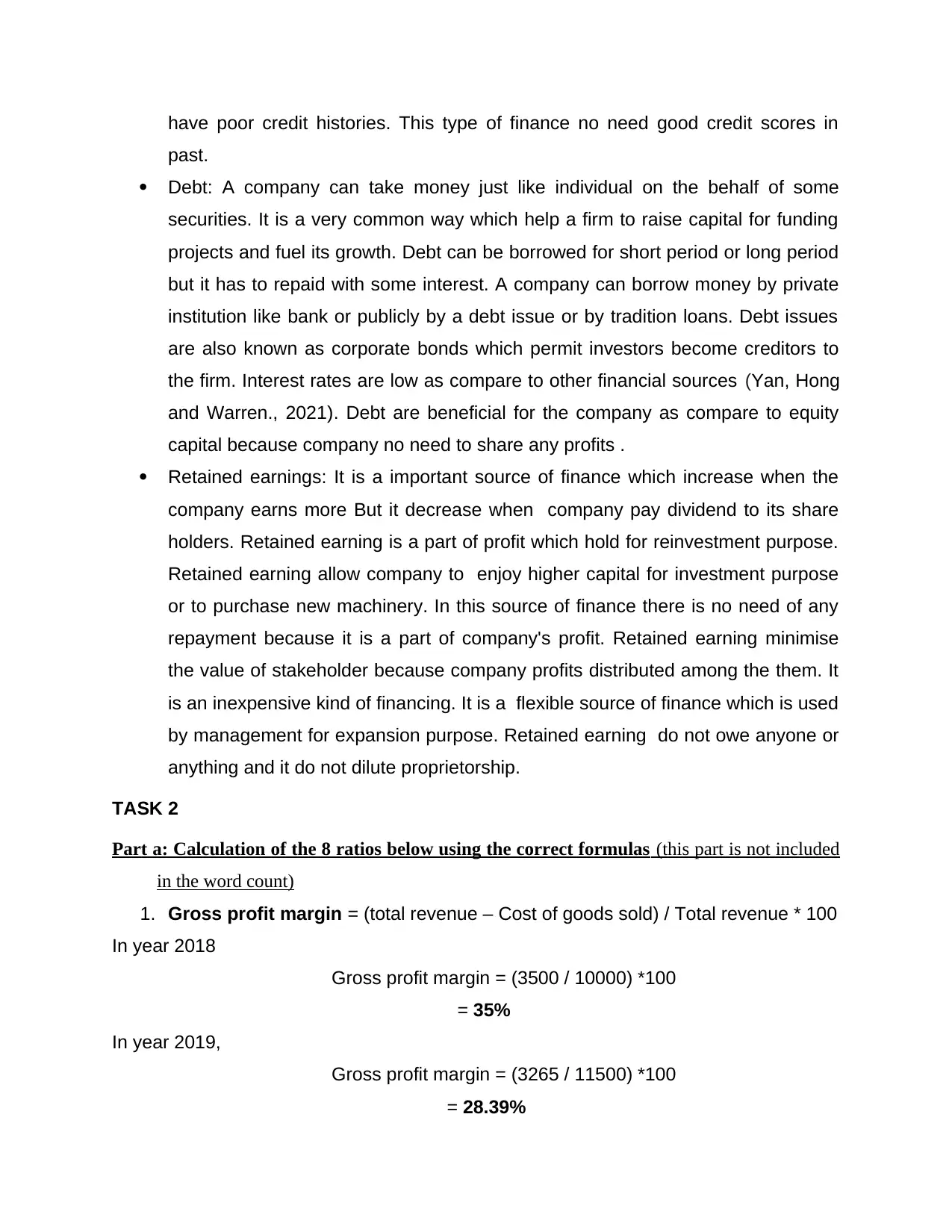
have poor credit histories. This type of finance no need good credit scores in
past.
Debt: A company can take money just like individual on the behalf of some
securities. It is a very common way which help a firm to raise capital for funding
projects and fuel its growth. Debt can be borrowed for short period or long period
but it has to repaid with some interest. A company can borrow money by private
institution like bank or publicly by a debt issue or by tradition loans. Debt issues
are also known as corporate bonds which permit investors become creditors to
the firm. Interest rates are low as compare to other financial sources (Yan, Hong
and Warren., 2021). Debt are beneficial for the company as compare to equity
capital because company no need to share any profits .
Retained earnings: It is a important source of finance which increase when the
company earns more But it decrease when company pay dividend to its share
holders. Retained earning is a part of profit which hold for reinvestment purpose.
Retained earning allow company to enjoy higher capital for investment purpose
or to purchase new machinery. In this source of finance there is no need of any
repayment because it is a part of company's profit. Retained earning minimise
the value of stakeholder because company profits distributed among the them. It
is an inexpensive kind of financing. It is a flexible source of finance which is used
by management for expansion purpose. Retained earning do not owe anyone or
anything and it do not dilute proprietorship.
TASK 2
Part a: Calculation of the 8 ratios below using the correct formulas (this part is not included
in the word count)
1. Gross profit margin = (total revenue – Cost of goods sold) / Total revenue * 100
In year 2018
Gross profit margin = (3500 / 10000) *100
= 35%
In year 2019,
Gross profit margin = (3265 / 11500) *100
= 28.39%
past.
Debt: A company can take money just like individual on the behalf of some
securities. It is a very common way which help a firm to raise capital for funding
projects and fuel its growth. Debt can be borrowed for short period or long period
but it has to repaid with some interest. A company can borrow money by private
institution like bank or publicly by a debt issue or by tradition loans. Debt issues
are also known as corporate bonds which permit investors become creditors to
the firm. Interest rates are low as compare to other financial sources (Yan, Hong
and Warren., 2021). Debt are beneficial for the company as compare to equity
capital because company no need to share any profits .
Retained earnings: It is a important source of finance which increase when the
company earns more But it decrease when company pay dividend to its share
holders. Retained earning is a part of profit which hold for reinvestment purpose.
Retained earning allow company to enjoy higher capital for investment purpose
or to purchase new machinery. In this source of finance there is no need of any
repayment because it is a part of company's profit. Retained earning minimise
the value of stakeholder because company profits distributed among the them. It
is an inexpensive kind of financing. It is a flexible source of finance which is used
by management for expansion purpose. Retained earning do not owe anyone or
anything and it do not dilute proprietorship.
TASK 2
Part a: Calculation of the 8 ratios below using the correct formulas (this part is not included
in the word count)
1. Gross profit margin = (total revenue – Cost of goods sold) / Total revenue * 100
In year 2018
Gross profit margin = (3500 / 10000) *100
= 35%
In year 2019,
Gross profit margin = (3265 / 11500) *100
= 28.39%
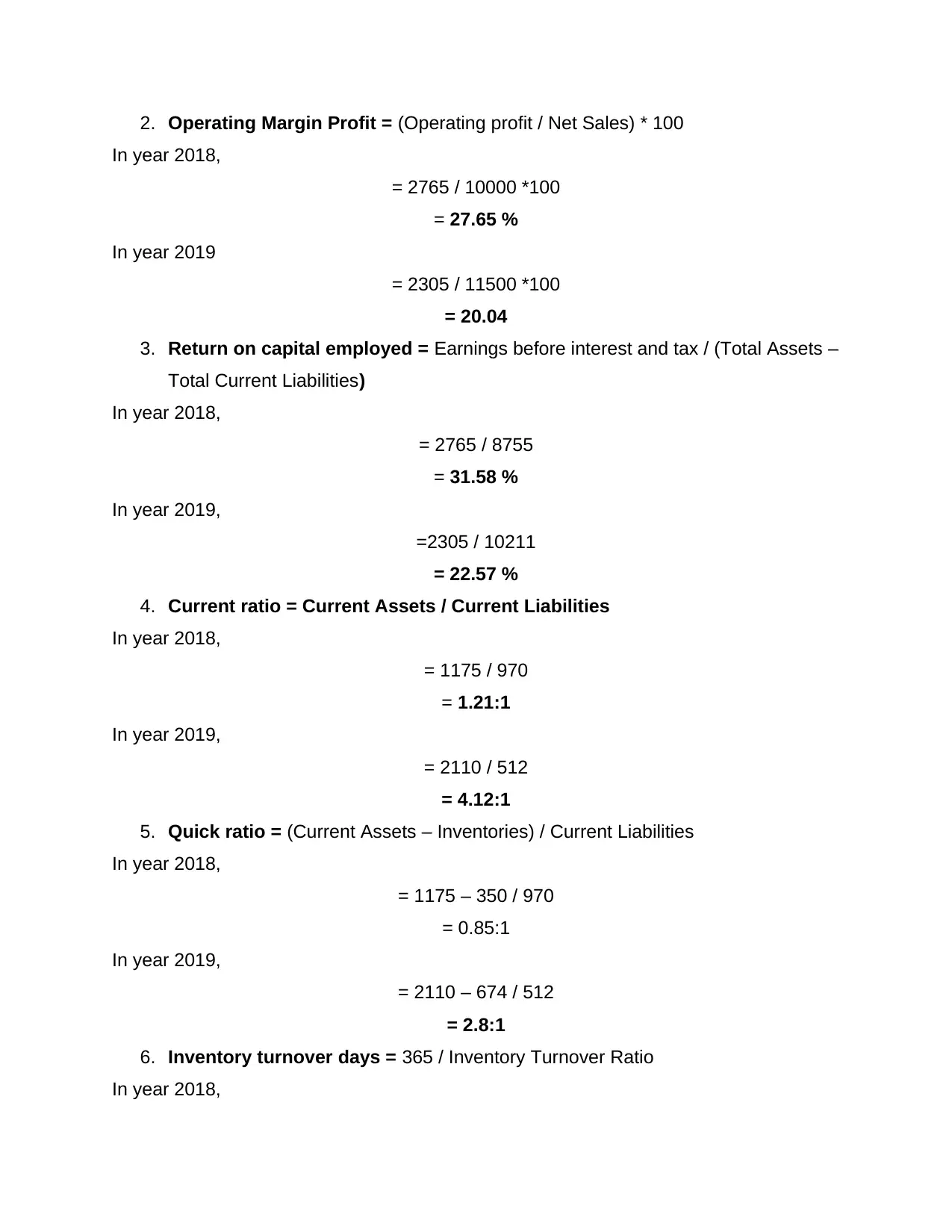
2. Operating Margin Profit = (Operating profit / Net Sales) * 100
In year 2018,
= 2765 / 10000 *100
= 27.65 %
In year 2019
= 2305 / 11500 *100
= 20.04
3. Return on capital employed = Earnings before interest and tax / (Total Assets –
Total Current Liabilities)
In year 2018,
= 2765 / 8755
= 31.58 %
In year 2019,
=2305 / 10211
= 22.57 %
4. Current ratio = Current Assets / Current Liabilities
In year 2018,
= 1175 / 970
= 1.21:1
In year 2019,
= 2110 / 512
= 4.12:1
5. Quick ratio = (Current Assets – Inventories) / Current Liabilities
In year 2018,
= 1175 – 350 / 970
= 0.85:1
In year 2019,
= 2110 – 674 / 512
= 2.8:1
6. Inventory turnover days = 365 / Inventory Turnover Ratio
In year 2018,
In year 2018,
= 2765 / 10000 *100
= 27.65 %
In year 2019
= 2305 / 11500 *100
= 20.04
3. Return on capital employed = Earnings before interest and tax / (Total Assets –
Total Current Liabilities)
In year 2018,
= 2765 / 8755
= 31.58 %
In year 2019,
=2305 / 10211
= 22.57 %
4. Current ratio = Current Assets / Current Liabilities
In year 2018,
= 1175 / 970
= 1.21:1
In year 2019,
= 2110 / 512
= 4.12:1
5. Quick ratio = (Current Assets – Inventories) / Current Liabilities
In year 2018,
= 1175 – 350 / 970
= 0.85:1
In year 2019,
= 2110 – 674 / 512
= 2.8:1
6. Inventory turnover days = 365 / Inventory Turnover Ratio
In year 2018,
⊘ This is a preview!⊘
Do you want full access?
Subscribe today to unlock all pages.

Trusted by 1+ million students worldwide
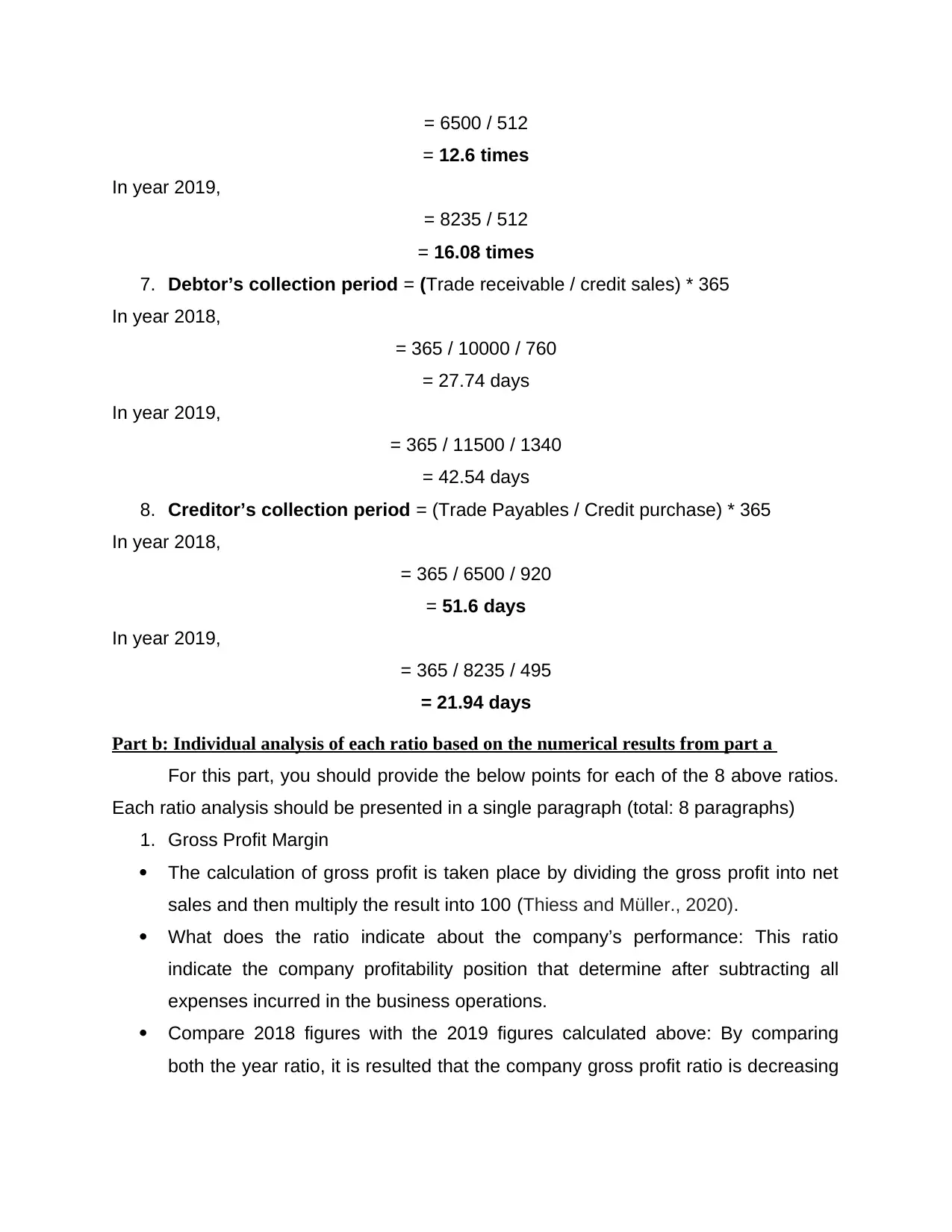
= 6500 / 512
= 12.6 times
In year 2019,
= 8235 / 512
= 16.08 times
7. Debtor’s collection period = (Trade receivable / credit sales) * 365
In year 2018,
= 365 / 10000 / 760
= 27.74 days
In year 2019,
= 365 / 11500 / 1340
= 42.54 days
8. Creditor’s collection period = (Trade Payables / Credit purchase) * 365
In year 2018,
= 365 / 6500 / 920
= 51.6 days
In year 2019,
= 365 / 8235 / 495
= 21.94 days
Part b: Individual analysis of each ratio based on the numerical results from part a
For this part, you should provide the below points for each of the 8 above ratios.
Each ratio analysis should be presented in a single paragraph (total: 8 paragraphs)
1. Gross Profit Margin
The calculation of gross profit is taken place by dividing the gross profit into net
sales and then multiply the result into 100 (Thiess and Müller., 2020).
What does the ratio indicate about the company’s performance: This ratio
indicate the company profitability position that determine after subtracting all
expenses incurred in the business operations.
Compare 2018 figures with the 2019 figures calculated above: By comparing
both the year ratio, it is resulted that the company gross profit ratio is decreasing
= 12.6 times
In year 2019,
= 8235 / 512
= 16.08 times
7. Debtor’s collection period = (Trade receivable / credit sales) * 365
In year 2018,
= 365 / 10000 / 760
= 27.74 days
In year 2019,
= 365 / 11500 / 1340
= 42.54 days
8. Creditor’s collection period = (Trade Payables / Credit purchase) * 365
In year 2018,
= 365 / 6500 / 920
= 51.6 days
In year 2019,
= 365 / 8235 / 495
= 21.94 days
Part b: Individual analysis of each ratio based on the numerical results from part a
For this part, you should provide the below points for each of the 8 above ratios.
Each ratio analysis should be presented in a single paragraph (total: 8 paragraphs)
1. Gross Profit Margin
The calculation of gross profit is taken place by dividing the gross profit into net
sales and then multiply the result into 100 (Thiess and Müller., 2020).
What does the ratio indicate about the company’s performance: This ratio
indicate the company profitability position that determine after subtracting all
expenses incurred in the business operations.
Compare 2018 figures with the 2019 figures calculated above: By comparing
both the year ratio, it is resulted that the company gross profit ratio is decreasing
Paraphrase This Document
Need a fresh take? Get an instant paraphrase of this document with our AI Paraphraser
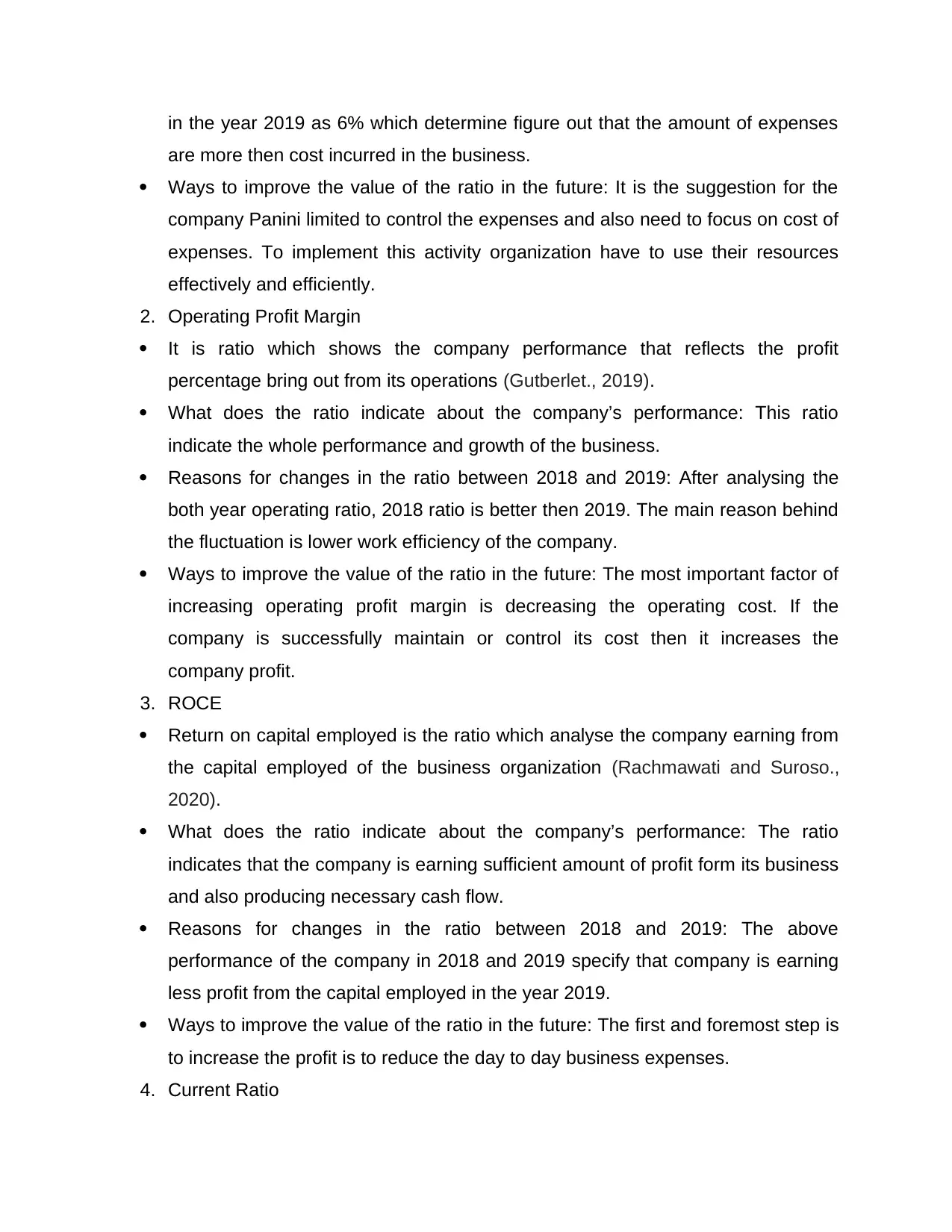
in the year 2019 as 6% which determine figure out that the amount of expenses
are more then cost incurred in the business.
Ways to improve the value of the ratio in the future: It is the suggestion for the
company Panini limited to control the expenses and also need to focus on cost of
expenses. To implement this activity organization have to use their resources
effectively and efficiently.
2. Operating Profit Margin
It is ratio which shows the company performance that reflects the profit
percentage bring out from its operations (Gutberlet., 2019).
What does the ratio indicate about the company’s performance: This ratio
indicate the whole performance and growth of the business.
Reasons for changes in the ratio between 2018 and 2019: After analysing the
both year operating ratio, 2018 ratio is better then 2019. The main reason behind
the fluctuation is lower work efficiency of the company.
Ways to improve the value of the ratio in the future: The most important factor of
increasing operating profit margin is decreasing the operating cost. If the
company is successfully maintain or control its cost then it increases the
company profit.
3. ROCE
Return on capital employed is the ratio which analyse the company earning from
the capital employed of the business organization (Rachmawati and Suroso.,
2020).
What does the ratio indicate about the company’s performance: The ratio
indicates that the company is earning sufficient amount of profit form its business
and also producing necessary cash flow.
Reasons for changes in the ratio between 2018 and 2019: The above
performance of the company in 2018 and 2019 specify that company is earning
less profit from the capital employed in the year 2019.
Ways to improve the value of the ratio in the future: The first and foremost step is
to increase the profit is to reduce the day to day business expenses.
4. Current Ratio
are more then cost incurred in the business.
Ways to improve the value of the ratio in the future: It is the suggestion for the
company Panini limited to control the expenses and also need to focus on cost of
expenses. To implement this activity organization have to use their resources
effectively and efficiently.
2. Operating Profit Margin
It is ratio which shows the company performance that reflects the profit
percentage bring out from its operations (Gutberlet., 2019).
What does the ratio indicate about the company’s performance: This ratio
indicate the whole performance and growth of the business.
Reasons for changes in the ratio between 2018 and 2019: After analysing the
both year operating ratio, 2018 ratio is better then 2019. The main reason behind
the fluctuation is lower work efficiency of the company.
Ways to improve the value of the ratio in the future: The most important factor of
increasing operating profit margin is decreasing the operating cost. If the
company is successfully maintain or control its cost then it increases the
company profit.
3. ROCE
Return on capital employed is the ratio which analyse the company earning from
the capital employed of the business organization (Rachmawati and Suroso.,
2020).
What does the ratio indicate about the company’s performance: The ratio
indicates that the company is earning sufficient amount of profit form its business
and also producing necessary cash flow.
Reasons for changes in the ratio between 2018 and 2019: The above
performance of the company in 2018 and 2019 specify that company is earning
less profit from the capital employed in the year 2019.
Ways to improve the value of the ratio in the future: The first and foremost step is
to increase the profit is to reduce the day to day business expenses.
4. Current Ratio
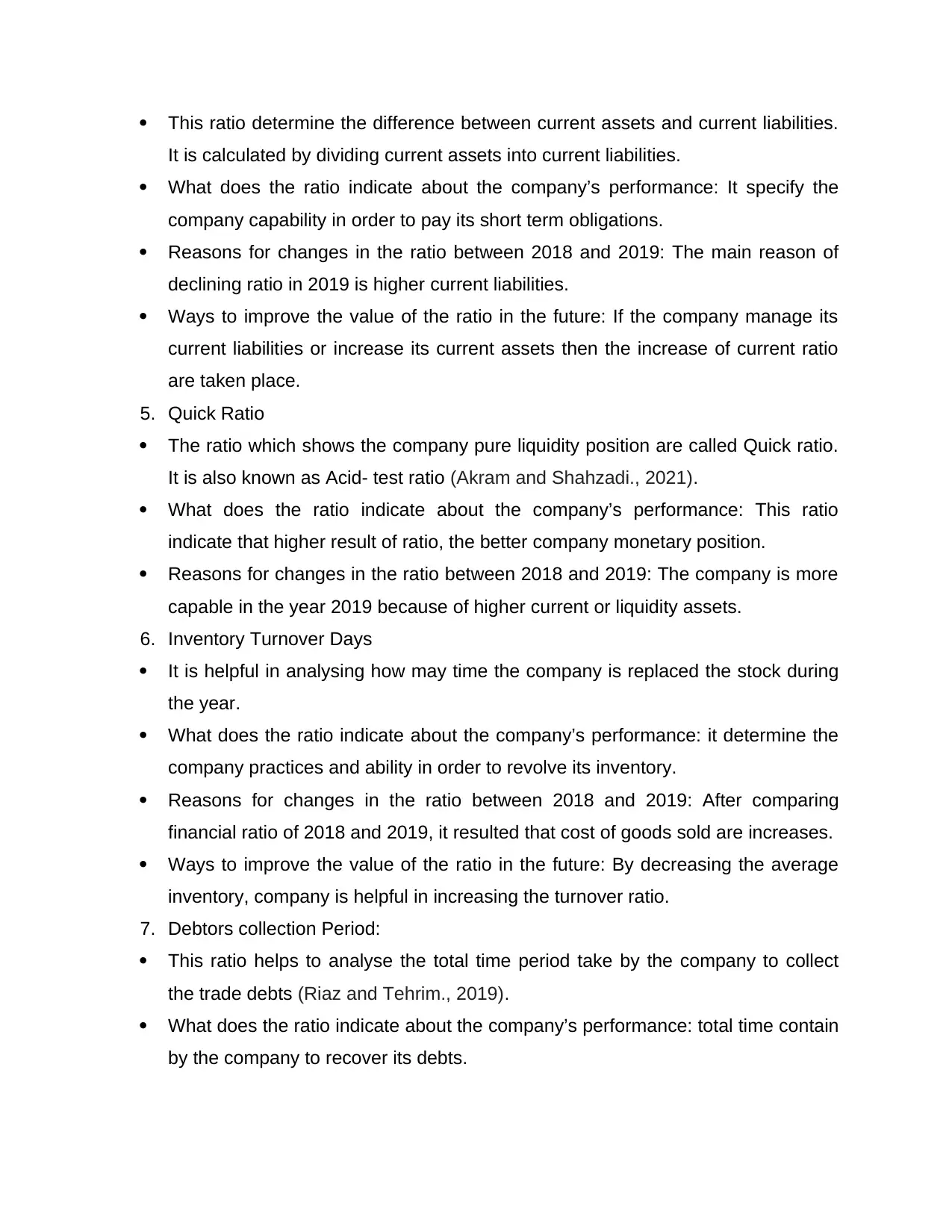
This ratio determine the difference between current assets and current liabilities.
It is calculated by dividing current assets into current liabilities.
What does the ratio indicate about the company’s performance: It specify the
company capability in order to pay its short term obligations.
Reasons for changes in the ratio between 2018 and 2019: The main reason of
declining ratio in 2019 is higher current liabilities.
Ways to improve the value of the ratio in the future: If the company manage its
current liabilities or increase its current assets then the increase of current ratio
are taken place.
5. Quick Ratio
The ratio which shows the company pure liquidity position are called Quick ratio.
It is also known as Acid- test ratio (Akram and Shahzadi., 2021).
What does the ratio indicate about the company’s performance: This ratio
indicate that higher result of ratio, the better company monetary position.
Reasons for changes in the ratio between 2018 and 2019: The company is more
capable in the year 2019 because of higher current or liquidity assets.
6. Inventory Turnover Days
It is helpful in analysing how may time the company is replaced the stock during
the year.
What does the ratio indicate about the company’s performance: it determine the
company practices and ability in order to revolve its inventory.
Reasons for changes in the ratio between 2018 and 2019: After comparing
financial ratio of 2018 and 2019, it resulted that cost of goods sold are increases.
Ways to improve the value of the ratio in the future: By decreasing the average
inventory, company is helpful in increasing the turnover ratio.
7. Debtors collection Period:
This ratio helps to analyse the total time period take by the company to collect
the trade debts (Riaz and Tehrim., 2019).
What does the ratio indicate about the company’s performance: total time contain
by the company to recover its debts.
It is calculated by dividing current assets into current liabilities.
What does the ratio indicate about the company’s performance: It specify the
company capability in order to pay its short term obligations.
Reasons for changes in the ratio between 2018 and 2019: The main reason of
declining ratio in 2019 is higher current liabilities.
Ways to improve the value of the ratio in the future: If the company manage its
current liabilities or increase its current assets then the increase of current ratio
are taken place.
5. Quick Ratio
The ratio which shows the company pure liquidity position are called Quick ratio.
It is also known as Acid- test ratio (Akram and Shahzadi., 2021).
What does the ratio indicate about the company’s performance: This ratio
indicate that higher result of ratio, the better company monetary position.
Reasons for changes in the ratio between 2018 and 2019: The company is more
capable in the year 2019 because of higher current or liquidity assets.
6. Inventory Turnover Days
It is helpful in analysing how may time the company is replaced the stock during
the year.
What does the ratio indicate about the company’s performance: it determine the
company practices and ability in order to revolve its inventory.
Reasons for changes in the ratio between 2018 and 2019: After comparing
financial ratio of 2018 and 2019, it resulted that cost of goods sold are increases.
Ways to improve the value of the ratio in the future: By decreasing the average
inventory, company is helpful in increasing the turnover ratio.
7. Debtors collection Period:
This ratio helps to analyse the total time period take by the company to collect
the trade debts (Riaz and Tehrim., 2019).
What does the ratio indicate about the company’s performance: total time contain
by the company to recover its debts.
⊘ This is a preview!⊘
Do you want full access?
Subscribe today to unlock all pages.

Trusted by 1+ million students worldwide
1 out of 14
Related Documents
Your All-in-One AI-Powered Toolkit for Academic Success.
+13062052269
info@desklib.com
Available 24*7 on WhatsApp / Email
![[object Object]](/_next/static/media/star-bottom.7253800d.svg)
Unlock your academic potential
Copyright © 2020–2025 A2Z Services. All Rights Reserved. Developed and managed by ZUCOL.
